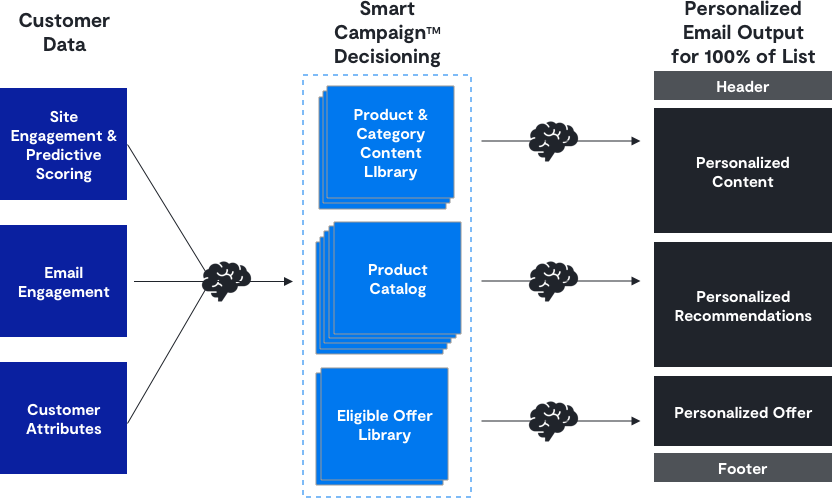
How to Deliver on the Promise of a Mass Personalized Email Blast
Sending email blasts? Pretty common. Sending personalized email blasts? Not an essential ingredient in most retailers’ email marketing programs — yet.
Traditionally, email marketing programs have focused on two categories of emails: Batch and blast (also known as bulk emails or mass emails) and triggered emails. However, a gap in the purchase funnel exists between these two email categories, leaving marketers with missed opportunities to engage customers and drive revenue.
The answer to filling this gap lies in personalized mass emails, which supplement top of the funnel batch and blast emails by re-engaging shoppers based on very specific interests without having to wait until those shoppers take action.
But if filling this gap is so important, why don’t more retailers take advantage of personalized batch emails?
In short, sending mass emails in a personalized manner has been difficult in the past. Thankfully, modern email marketing technology has changed that, meaning the promise of personalized batch emails is here.

Why Personalized Mass Email Blasts Have Eluded Marketers
You can’t run an effective personalized batch campaign unless you can intelligently calculate personalized product recommendations for your entire list of email subscribers. But most retailers only have enough recent data to drive true 1:1 personalization for about 20% of their email lists.
And therein lies the problem: You’re constrained from the start if you can’t create the personalized customer experience that 80% of shoppers want.
This challenge has led to the status quo in which marketers run personalized campaigns for a subset of their audience and send generic messages to the rest of their customers. Critically, this process is just rinse and repeat for each email send, with marketers delivering a new generic message each time since it’s been nearly impossible to take into account any feedback about customer engagement and make adjustments accordingly.
Additionally, executing mass personalized emails at scale has proven difficult from a workflow perspective. In the past, it required marketers to make a series of decisions about how to segment their audience as well as which messages, creative and product recommendations to get in front of each group. From there, marketers still had to design email templates for each of those groups, resulting in a very manual and time-consuming process.
Even after all that, marketers were left with a majority of their list falling into a group for which they couldn’t personalize and thus ended up with a generic message. The missed opportunity got further compounded since marketers couldn’t capture learnings on how each shopper interacted with the email they did receive to make adjustments for subsequent email sends.
How To Deliver Personalized Email Blasts
Modern email marketing technology has completely changed the game. It’s putting the promise of personalized mass emails well within reach of retail marketing teams by offering smart personalization for all customers — regardless of the amount of data available on them — and simplifying the workflows required to send these types of campaigns.
From a personalization perspective, retailers can use artificial intelligence to intelligently target the 80% of email subscribers for whom data is minimal. Modern email marketing technology fills this gap by using feedback loops to explore and continuously learn what works and doesn’t work for these shoppers and then respond accordingly in the next email.
It’s important to note this personalization goes beyond a name or subject lines. We are talking product recommendations, restock alerts, and much more.
For example, a personalized batch email campaign might start out by randomizing recommendations for these customers based on the most popular category-specific best sellers. It will then take into account engagement for the first send as well as any other behavioral data captured when deciding what to show each customer the next time around. Those who engaged with the email will see more product recommendations from the same category, while those who did not will see product recommendations from a different category or a different sample of products from within the same category (e.g. discount products instead of full price products or new arrivals instead of best sellers).
Importantly, the AI also pairs these product recommendations with relevant content and offers so that the entire email feels coherent and so that customers see the appropriate message based on factors like loyalty status and whether or not they have a store credit card.

Ultimately, this ability to listen to customer engagement and optimize at a 1:1 level allows personalized emails to get smarter over time. In turn, this helps shoppers discover new categories and products while further enabling better personalization in future messages and making shoppers eligible for higher performing triggers further down the conversion funnel.
A lot changes from a workflow perspective too. The use of AI allows marketers to hand over more decisioning to technology, which simplifies the process and scales email performance while allowing marketers to focus solely on the message and less on segmentation. From there, the technology will take over to personalize that message by pairing each customer with the most relevant content, products and offers.
Modern email technology eliminates the manual workflows that previously prevented personalization at scale and enables marketers to achieve 100% personalization through a single template.
Do You Have the Right Technology to Power Personalized Mass Email Blasts?
To date, personalized batch has been difficult to execute, but today that’s no longer the case. Thanks to modern, AI-driven retail email marketing technology, the promise of personalized mass emails — including higher engagement and revenue — is well within reach.





